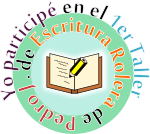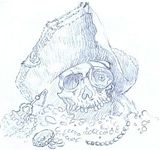http://www.wizards.com/DnD/Article.aspx?x=dnd/drdd/20120208
Información:
Designing Chaos: Classes and Themes
Design & Development
By Robert J. Schwalb
What is elemental power and how do player characters use it? These questions confronted me last winter at D&D Experience and would drive my work in the upcoming Player's Option: Heroes of the Elemental Chaos. Considering the classes already populating the game, along with themes, feat chains, and a variety of other rules elements for character customization, the idea of introducing a new power source with attendant classes was daunting. Further complicating the assignment was how elemental power had already crept into the game. You can see it in the chaos sorcerer, in wizard powers, and in the primal classes. And once you dig into magic items, paragon paths, and other options, you find elemental "pollution" throughout the game. Because characters can already access elemental energy in one form or another, making the elemental power source distinct seemed to be an impossible task.
And then an idea punched me in the mouth. The key was in how and why a character would use elemental power. D&D characters can access elemental energy through other mediums. A chaos sorcerer apprehends the raw power from the Plane Below through an arcane conduit. Primal characters who evoke elemental power do so with aid from primal spirits. Clerics of the earth domain can manipulate elemental earth with the aid of the divine. In every case, one of the other magical traditions grants access to elemental energy.
With this idea in mind, I realized that for elemental power to exist, it must do so in a way that makes the connection to other power sources logical. Other adventurers must rely on different forms of magic to access elemental energy because they lack the means to harness it directly. This idea led me to the conclusion that elemental power ought to be something exclusive to elemental creatures. By extension, powers with the elemental keyword would then be manifestations of an elemental's essential nature.
It was a high concept and a weird idea—this move to make elemental magic a metaphysical extension of a creature—and one hard to introduce to D&D players because there's only one elemental race (the genasi) to choose from. But it made sense to me as a solution to the problems I identified at the project's start. What I needed was a way to transform existing characters into elementals but do it in a way that did not require a feat cost (because that's pretty boring). We discussed creating new races, but we abandoned that route because we wanted players with existing characters to be able to pick up and use it. So we turned to character themes, a popular and flexible tool. We could create several themes that would carry the responsibility of transformation and grant existing characters access to the power source without having to make extensive revisions to the character sheet.
Most of the starting features of the themes in the book change the creature's origin and reveal a couple of ways this might have happened. Take the demon spawn (a theme designed to bring forward the concept of the alu-demon from the 1st edition Monster Manual 2). A character with this theme discovers his or her demonic heritage when it manifests in the body—horns, vestigial wings, tail, and the like. The character may be a member of another race, but has enough demonic blood to also count as an elemental. Other themes, such as the firecrafter, come by their elemental apotheosis by way of primordial shards, having latent elemental heritage, or through exposure to the Elemental Chaos.
With the elemental heritage problem solved, we could explore how to make elemental powers different from existing powers that employ elemental energy. Theme powers and benefits tend to focus on the particular element associated with the theme. For example, the watershaper theme grants the buffeting wave power that creates a wall of water you can send crashing down on your enemies. The theme also offers thematic benefits that reflect the larger concept of the elements. Water is often linked to communication, shape changing, and healing, so watershapers gain boosts to Heal and Insight, a power that creates a mental link between you and your allies, and another power that lets you change your appearance and stay that way for a nice long time.
Although the book puts forward the idea that elemental magic belongs to elemental creatures, there are exceptions. A character can wield true elemental magic, thanks to help from an elemental patron. The janissary theme grants access to elemental powers from a genie patron. When the janissary uses an elemental power, he or she is in fact drawing this power directly from the patron.
Although themes do a lot of the work presenting the power source, we added a selection of class expansions to show how certain classes with historical ties to elemental energy might employ these powers. Choosing the classes to expand was not easy, but themes helped us eliminate several classes from the mix. We could have created an "elemental fighter," but there was no reason to. If you want to play an elemental-flavored fighter, you need only pick an elemental theme and you're there. Collecting a few elemental items, feats, a paragon path, and other mechanical nuggets could help further express your connection without having to blur the lines between fighter and another class.

In the end, we picked five classes to expand: druid, monk, sorcerer, warlock, and wizard. In each case, we considered whether to produce a new subclass or expand an existing class with a new build (sometimes after a subclass had been designed). With the exception of the sorcerer, we opted to expand the classes instead of create new versions of them. The reason? If you're reading this, you probably have a character already. Rather than make you create a new character or substantially revise your existing character, we wanted you to be able to use the material with as little modification as possible. This way, if you're playing a Player's Handbook warlock, you can change your pact, choose different powers, or do both, but still keep your basic character concept intact.
Fans of the DARK SUN campaign setting will find a lot to like in the class chapter, because these elemental characteristics can easily fit into an existing game (as well as other campaign settings, for that matter). Sentinel druids can now choose the Druid of the Wastes option and wield elemental magic to protect the world's desolate places, a nice fit for a desert world.
Just as the book gives a nod to DARK SUN, we also recall the Al-Qadim setting from 2nd Edition. I always found the sha'ir kit interesting and compelling, and so bringing this concept back as a wizard build let us resurrect a great concept left behind from a previous edition. By choosing the sha'ir build, you gain the service of a gen servant, who pops off to fetch spells for you from the powers in the Elemental Chaos. Your alliance with this minor elemental grants you access to a wide range of elemental powers, from a Harry Potter-inspired watery sphere to classic spells such as Melf's minute meteors, dig, and reverse gravity. Even if you don't choose the sha'ir build, the new wizard powers are available to all wizards, offering cool new spells no matter what kind of wizard you play.
While the monk and warlock follow the pattern and mechanical expansions we designed for the druid and wizard, we opted to create a new subclass for the sorcerer. There had been a lot of discussion about creating an easy-to-play spellcaster, in the same way that the slayer is a simplified warrior. The elementalist draws power directly from the Elemental Chaos, flavored by the specialty chosen when created. The elementalist can hurl elemental bolts or use elemental powers unique to the subclass. The specialty modifies the class's elemental bolt power, giving it a damage type and a power-up option. Since the elementalist does not gain daily attack powers, the class's at-wills tend to be more powerful. The result is a potent and effective striker that anyone can play and have a good time with.
Player's Option: Heroes of the Elemental Chaos proved to be an interesting project since it let Rich Baker and me delve into an area of the game both familiar and new. A lot of material from the older editions that recalls the Inner Planes survives in new classes and themes tied to the Elemental Chaos. Furthermore, the options in this book let you decide how deeply you want to embrace elemental power. You might find an elemental relic and channel its power, or absorb raw chaotic energy and become a true hero of the Elemental Chaos. With elemental power at your command, there is little you cannot do.
About the Author
Robert J. Schwalb has contributed design to or developed nearly two hundred roleplaying game titles for DUNGEONS & DRAGONS, Warhammer Fantasy Roleplay, A Song of Ice and Fire RPG, Star Wars RPG, and the d20 system. Some of his more recent work for Wizards of the Coast can be found in Book of Vile Darkness, the Spiral of Tharizdun fortune card set, and the novel Death Mark. Rob is also a regular contributor to both Dragon and Dungeon magazines. For more information about the author, be sure to check out his website at www.robertjschwalb.com or follow him on Twitter (@rjschwalb).








No hay comentarios:
Publicar un comentario